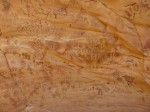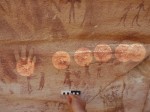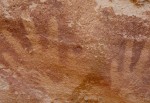 The 8,000-year-old rock art painted on a walls of the Wadi Sūra II in the Sahara Desert is replete with handprints. It’s a common theme in ancient rock art. Artists used their hands as stencils and painted or blew pigment around them leaving a negative handprint. The cave was discovered in 2002 about six miles from the famous Cave of Swimmers which featured prominently in that endless bore of a movie, The English Patient. It’s 66 feet long and 26 feet deep and there are about 900 stencil paintings on the wall. In addition to the hands, artists used arms, feet, circular objects and sticks as stencils and red, yellow, orange and brown pigments. There are also drawings of headless people and a variety of wildlife which inspired the nickname Cave of the Beasts.
The 8,000-year-old rock art painted on a walls of the Wadi Sūra II in the Sahara Desert is replete with handprints. It’s a common theme in ancient rock art. Artists used their hands as stencils and painted or blew pigment around them leaving a negative handprint. The cave was discovered in 2002 about six miles from the famous Cave of Swimmers which featured prominently in that endless bore of a movie, The English Patient. It’s 66 feet long and 26 feet deep and there are about 900 stencil paintings on the wall. In addition to the hands, artists used arms, feet, circular objects and sticks as stencils and red, yellow, orange and brown pigments. There are also drawings of headless people and a variety of wildlife which inspired the nickname Cave of the Beasts.
 Among the hundreds of adult human handprints are 13 tiny hands. While children’s handprints have been found in ancient rock art from Argentina to Australia, they’ve never been found before in the Sahara. When anthropologist Emmanuelle Honoré of the McDonald Institute for Archaeological Research first saw the small handprints in Wadi Sura II in 2006, she was shocked. They looked too tiny to be the hands of babies even a very small baby wouldn’t have the long, thin fingers of the prints on the cave wall.
Among the hundreds of adult human handprints are 13 tiny hands. While children’s handprints have been found in ancient rock art from Argentina to Australia, they’ve never been found before in the Sahara. When anthropologist Emmanuelle Honoré of the McDonald Institute for Archaeological Research first saw the small handprints in Wadi Sura II in 2006, she was shocked. They looked too tiny to be the hands of babies even a very small baby wouldn’t have the long, thin fingers of the prints on the cave wall.
 Honoré took precise measurements of the handprints and set out to compare them to the hands of newborns and, because the prints are so small, to premature babies as well. Since she couldn’t very well just march into a maternity ward and demand to measure the hands of premies and full-term neonates, Honoré teamed up with doctors from the perinatal department of the Lille University School of Medicine, the largest medical school in France. They collected hand measurements from infants of 37 to 41 weeks gestational age and premature babies from 26 to 36 weeks gestational age. The parents of the babies, incidentally, were excited that their newborns would start off life contributing to a scientific study.
Honoré took precise measurements of the handprints and set out to compare them to the hands of newborns and, because the prints are so small, to premature babies as well. Since she couldn’t very well just march into a maternity ward and demand to measure the hands of premies and full-term neonates, Honoré teamed up with doctors from the perinatal department of the Lille University School of Medicine, the largest medical school in France. They collected hand measurements from infants of 37 to 41 weeks gestational age and premature babies from 26 to 36 weeks gestational age. The parents of the babies, incidentally, were excited that their newborns would start off life contributing to a scientific study.
Just as Honoré suspected, the proportions were way off. She considered whether the stencils might have been wooden or clay molds, but the finger and hand positions were too irregular for that. Honoré then looked to other animals. Monkeys seemed likely candidates, but again the proportions didn’t work.
 While doing research at a crocodile farm in Zambia, it occurred to Honoré that a reptile hand was a possibility. Reptiles like young crocodiles and desert monitor lizards leave handprints that at first glance look surprisingly like baby human hands. Crocodiles didn’t live there 8,000 years ago and would have had to have been transported to the Wadi Sura II area, or at least the feet would have. The desert monitor lizard, on the other hand, was native to the region, and its forefeet are tiny with long fingers, just like the stencils. Even today the desert monitor lizard lives in the area and is considered a protective force to the nomadic tribes who share their ecosystem.
While doing research at a crocodile farm in Zambia, it occurred to Honoré that a reptile hand was a possibility. Reptiles like young crocodiles and desert monitor lizards leave handprints that at first glance look surprisingly like baby human hands. Crocodiles didn’t live there 8,000 years ago and would have had to have been transported to the Wadi Sura II area, or at least the feet would have. The desert monitor lizard, on the other hand, was native to the region, and its forefeet are tiny with long fingers, just like the stencils. Even today the desert monitor lizard lives in the area and is considered a protective force to the nomadic tribes who share their ecosystem.
Other prehistoric cultures used animals as stencils for their rock art. For example, the Aboriginal people used emu foot stencils in the Carnarvon Gorge and Tent Shelter in Australia, and choike/nandu (birds in the genus Rhea) stencils are in the rock art at La Cueva de las Manos in Argentina, the researchers wrote in the study.
It’s unclear why the ancient people at Wadi Sūra II used reptile hands as stencils, but Honoré said she’s working on a new study that analyzes possible reasons.
“I think we have to remain a bit prudent,” she said. “We have to explore all of the hypotheses without taking anything for granted.”
She’s also prudently avoiding speculation on whether the animal’s foot was severed before it was used as an artist’s stencil or whether the artists actually pressed the wee foot of a living lizard up to the wall.
This is the first time non-human five-fingered hand stencils have been discovered in rock art anywhere in the world. The study has been published in the latest issue of the Journal of Archaeological Science.
There is of course the Western Sahara crocodile (crocodylus suchus). Who knows if those human hands had been severed either, and what about monkeys ?
Monkeys didn’t fit. They are doing a study on crocodiles now, but it’s not finished yet.
I think you should read the article again. 🙂
:giggle:
They are the hands of tiny E.Ts. 😉
Adorable! I want a tiny E.T.!
I am amazed that I finally found someone who agreed with me that “The English Patient” is one of the most boring motion pictures I’ve ever seen! All I ever heard was what a wonderful movie it was and I kept wondering WHY. Or I thought that maybe I actually fell asleep while watching it and missed the exciting part of it. Thank you for letting me know that I wasn’t the only person in the world who thought so.
Many animals have human-like hands including raccoons and opossums, however I don’t know what animals would have lived in that area in that era…
There’s an episode of Seinfeld where Elaine is forced to sit through The English Patient until she finally explodes. I know exactly how she felt. I have never wanted to do violence to a theater chair like I did while waiting for that endless torture of a movie to end. I bet there are more of us in The English Patient Sucks Club than we know, Classof65.
Looks like a raccoon print, lol.
I wonder what the symbolic meaning was, if it had to do with some sort of protection or benevolence, or “oneness” with whichever animal it portrayed – or, if it was indeed meant to represent a smaller human hand/child hand.
What has been referred to as ‘5.9 kiloyear event‘ is said to have triggered migration to river valleys, such as from central North Africa to the Nile valley. Thus, someone might have wanted to express (in very ancient Ancient Egyptian): “Hands off !” 😉
Yes, I regret to have missed the monkey reference – and particularly to have watched a film with a similar plot: From what I remember it was about giving Nicolas Cage a Lethal Injection. Nicolas himself might be a nice guy, but I had mixed feelings when I found out that stronger and stronger I had the wish someone would finish him off.
So our ancestors might have taken lizards into caves, held them up to the walls and blown pigment on them….and people tell me that I have strange hobbies….
Don’t jump to extra terrestrial hands. May be from a family with genetic abnormalities documenting their affliction or in the reverse showcasing their recovery overcoming a defect.